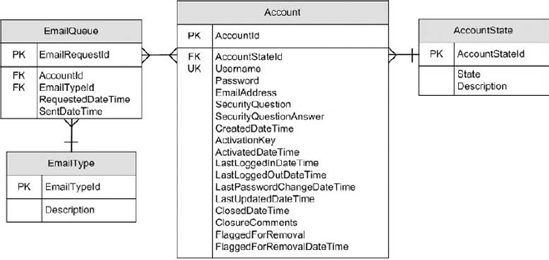14.5. The Logical Data Model and Data Access
Most applications use a database or some type of data store. Maybe one day you will not need to continue to send information to a database or data store, and everything will be held in memory. In the meantime, there is a need to store the data somewhere, and the database is generally the place for it. In physical terms, this architectural layer contains the actual tables, views, and stored procedures, along with any other database-specific elements, such as triggers, functions, configuration files, and security settings that belong to the physical database or databases.
Figure 14-16 shows the sample logical data model.
Figure 14.16. Figure 14-16

I've chosen not to use a prefix or naming convention for the logical data model. This can be applied later, if necessary. The logical data model contains the main Account table and associated tables. At this point it would be a very good idea to compare the logical data model against the requirements outlined in Chapter 13 to ensure that everything has been captured appropriately. While this may seem long-winded, it really does help to ensure that all the requirements have been captured appropriately and corrected where necessary. For the purposes of space and time in the book, we'll not go over all the requirements again. If we were to have done this throughout the chapter then this would ...
Get Design – Build – Run: Applied Practices and Principles for Production-Ready Software Development now with the O’Reilly learning platform.
O’Reilly members experience books, live events, courses curated by job role, and more from O’Reilly and nearly 200 top publishers.

